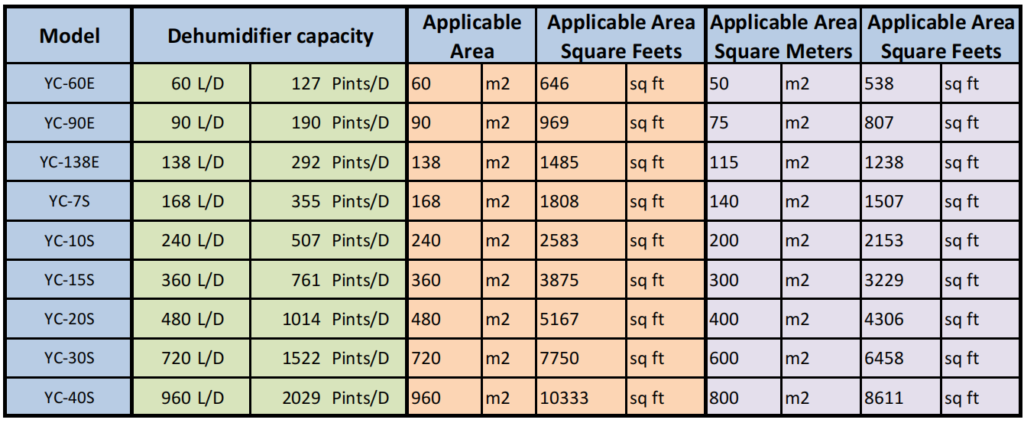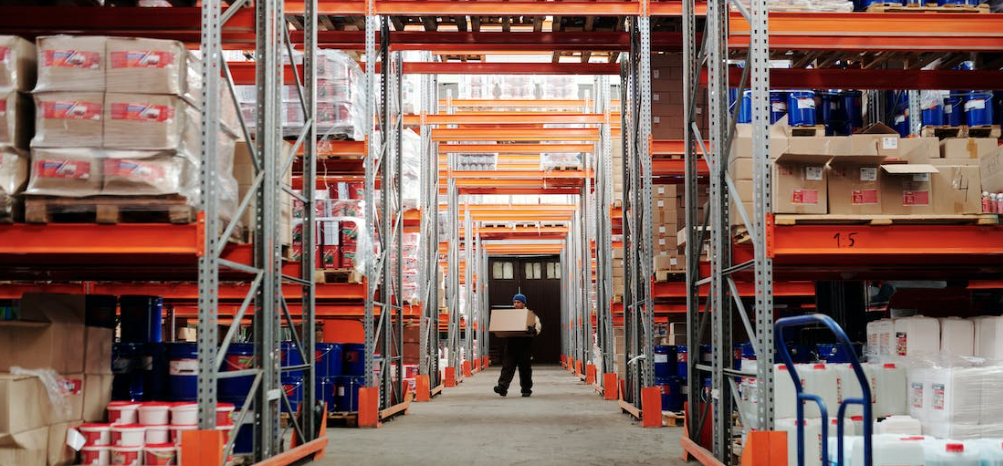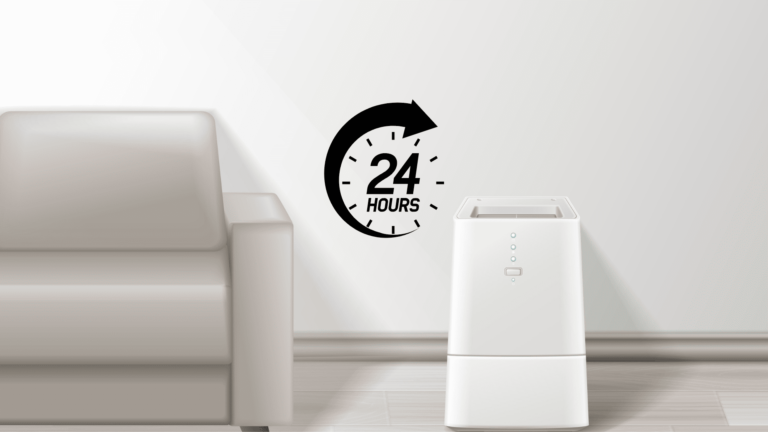We often encounter various places that need to use dehumidifiers, so how many dehumidifiers are suitable for us to use? Here, I will introduce to you a simple tip for calculating how many dehumidifiers to use.
We tentatively set the height as 3m. Taking YC-10S as an example. YC-10S can cover up to 260m2 at most, but in different application scenarios, the area that the dehumidifier can manage will vary. For example, in a large underground garage, the target humidity is 60-70% RH. As long as the ground is dry and the wheels will not slip, it is an application scenario with low requirements. In the planting room, plants need to be watered many times a day, which belongs to highly demanding application scenarios, etc.
For the humidity requirements, we divide the humidity requirements into low, medium and high to calculate the number of dehumidifiers. For places with high humidity calculation requirements, please ask local engineers to make detailed calculations according to actual conditions.
Low Requirement: Underground Parking

For places with low humidity control requirements for dehumidifiers, we recommend that the target site area be 0.8L to manage 1 square meter.
For example: If the underground garage is 900 square meters, the target humidity is around 60-70% RH, 900*0.8/240=3pcs, use three 240L dehumidifiers, and use YC-10S*3pcs is ok.
In this scenario, as long as the ground of the underground parking garage is dry and the wheels do not slip, it is fine. So the dehumidifier can dehumidify slowly, even taking several hours to reach the target humidity.
There is no special requirement for the time to reach the target humidity. The specific time is determined by the actual humidity and airtightness of the warehouse.
Recommended for: Garages, basements, etc.
Medium Requirement: Warehouse
Small Warehouse

For warehouses that have certain requirements for humidity control of dehumidifiers. So we recommend that the target site area is 1L to manage 1 square meter.
For example: If the warehouse is 900 square meters, the target humidity is 60-70% RH 900*1/240=3.75≈4pcs, use 4 sets of 240L dehumidifiers, YC-10S is enough.
In this scenario, a dehumidifier is required to control the humidity of the entire warehouse as soon as possible to reduce the humidity.
Recommended: Large warehouses that store various products, such as clothing, furniture, food, etc.
The difference between 1L and 1.2 l mainly depends on the airtightness of the warehouse. If the warehouse door is often stocked and unloaded, the window is poor in airtightness, and a large number of goods are stored in the warehouse, it can be calculated according to 1.2 L. If the warehouse is very well sealed and the goods inside the warehouse are not much, it can also be estimated by 1 liter.
Large Warehouse

For large warehouses, if a large number of dehumidifiers are placed inside, the experience feeling will be bad, because the dehumidifier occupies a lot of space, which will affect the arrangement of the warehouse itself for storage. In this case, we would recommend using a larger dehumidifier, such as a 480L dehumidifier per day.
Case Study:
- Application: Malaysia: Furniture supplies warehouse (such as bed, sofa, etc.) without fresh air. Block A section
- Area(LWH) : Block A, 13807m2. Length =146.129 m (479 ‘5’); Width = 94.484 m (310 ‘); Height = 9.144m (30 ‘) (the highest part is 16m)
- Aim humidity: below 60%RH (around 55%RH)
- Temperature: 23-34 degrees in the daytime (year-round) and 20 degrees in the evening
According to the actual situation, we recommend that 1 liter cover 1 square meter. 13807/480=28.7 sets, considering the actual gate, etc., it is recommended to use about 29-32 sets.
Recommended: large warehouses storing all kinds of products, the specific model selection can follow up the requirements of the site for analysis.
Precautions for using a dehumidifier in a warehouse
Using a dehumidifier in the special warehouse will have various problems in actual use. For example, when the warehouse is receiving and delivering goods, the door is always open, and the humidity control of the space near the door will be poor. When the temperature of the dehumidifier is low in winter, the dehumidification situation will respond slower than in summer, and so on. Moreover, if many doors of the warehouse are kept open, the dehumidification effect will definitely be affected.
Of course, opening the warehouse door on a sunny day will have less impact. Because the outdoor air humidity is not too high on a sunny day. If it rains, the impact will be very big, equal to the introduction of wet air from the outside, and will cause a lot of waste of energy. Because industrial dehumidifiers need to constantly process the humid air coming in from outside.
Therefore, in the absence of a large number of goods in and out of the case, please try to close the rest of the door; only the daily entry and exit of the door can be.
High Requirement: Growing Room

The planting room is a highly demanding dehumidification project, because the plants are regularly watered every day. The humidity in the planting room will rise rapidly after watering. And then the dehumidifier will enter a new round of dehumidification mode.
Therefore, for planting sites with high requirements for dehumidifier humidity control, we recommend that the target site area is 1.2L to manage 1 square meter.
For example: If the marijuana planting area is 900 square meters, the target humidity is 50-60% RH 900*1.2/240=4.5≈5pcs, and five 240L dehumidifiers are used, YC-10S is enough.
In this scenario, more dehumidifiers are needed to quickly and stably control the humidity. In the same way, if the watering is frequent and the airtightness is not good enough, it can be calculated as 1.5 liters.
Recommended: cannabis planting, tomato, dragon fruit planting and other greenhouse planting projects.
The special case of bringing in fresh air

The calculation and induction of the above three types of places can only simply calculate the number of dehumidifiers. But it is not applicable to all places of use.
Because there will be various problems in actual use. For example, when receiving and delivering goods in the warehouse, the door is always open, and the humidity control of the space near the door will be poor. Sometimes, the dehumidification situation will respond slower than in summer, etc.
What needs special attention is that in the factory workshop and planting room where fresh air is brought in, it can be understood that part of the air dried by the dehumidifier in the room is replaced to the outside, and the fresh air from the outside is exchanged to the room continuously. The exchange action of the dehumidifier will increase the working pressure of the dehumidifier. To control the humidity in the room, it is necessary to increase the number of dehumidifiers. The number of dehumidifiers that need to be configured will have a great relationship with the fresh air. For the specific value, we recommend that local professional engineers conduct detailed analysis according to the actual situation of the fresh air system.
Summary
Configuration draft
Through this article, I hope to help you to calculate the number of dehumidifier liters and the number of dehumidifier configurations in a simple scenario. In addition, after you provide the warehouse project drawings requiring the configuration of dehumidifiers, our engineers will follow up the actual situation for configuration, such as avoiding posts, shelves and other positions, and make sketches to refer to the placement.
The problem of humidity control

Even in the same warehouse, the setting of the target humidity will cause the dehumidifier to enter the dehumidification mode inconsistently. And the actual situation of each site is different, such as the position of the shelf, the height of the display, the airtightness of the warehouse, etc., so many problems need to be adjusted according to the actual use situation. In this article, we discuss the initial configuration issues, which are generally fine and can be adjusted after specific use based on your feedback.
Additional issues with configuring a dehumidifier
In each actual usage scenario, it needs to be analyzed on a case-by-case basis. Therefore, please provide as much detailed information as possible when we communicate the project status.
Case 1: A customer bought a dehumidifier and sold it to end customers, but it broke down after one year, because it was not informed that it was a food factory workshop. Most food factories are corrosive and need to be treated with preservatives.
Case 2: A customer purchased a dehumidifier and then sold it to the end customer. The feedback after use was that the dehumidification effect was poor, and the dehumidifier kept entering the defrosting mode. Because the customer used the warehouse at 10 degrees and did not inform us in advance. The dehumidifier of the compression model is most suitable for use at room temperature. If it is needed to be used in the environment of 10 degrees for a long time, it is necessary to customize the low-temperature dehumidifier.
About the dehumidifier project, you are welcome to consult!





